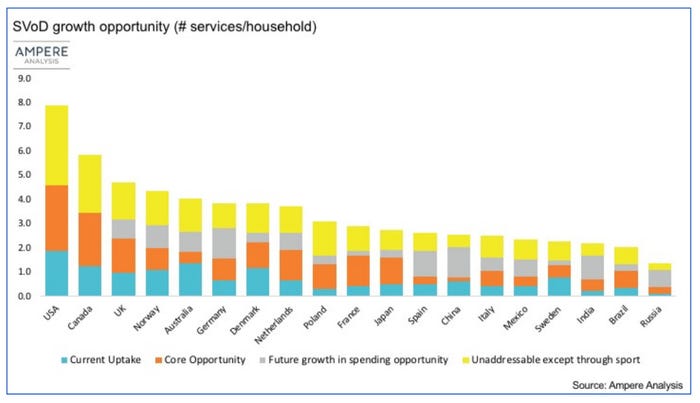Consumers are stacking it up when it comes to video streaming
Consumers in major global media markets are willing to subscribe to between two and four additional video streaming services, which translates to a possible 3 billion more SVoD contracts.
August 18, 2020

Consumers in major global media markets are willing to subscribe to between two and four additional video streaming services, which translates to a possible 3 billion more SVoD contracts.
That’s good news for SVoD providers, for whom competition is intense as consumers choose which content matters to them most, and potentially bad news for pay-TV companies, although premium sports rights could well be the latter’s saving grace.
Essentially, consumers are willing to spend as much on SVoD as they currently spend – or spent, in the case of cord-cutters – on pay-TV subscriptions. That’s according to Ampere Analysis, which has just published new research that covers the world’s 20 largest pay-TV markets.
In the US, where average household expenditure on TV subscription services comes in at just under US$900 per year, that means as many as eight SVoD services.
Of course, in other markets the figure is much lower. Major European economies have a capacity – or theoretical stacking ceiling, as the analyst firm puts it – of four or five SVoD services.

However, there are factors that make that theoretical figure virtually impossible to attain, chief among which is premium content, specifically sport. For the most part, top-end sports rights are currently in the hands of pay TV operators and networks and Ampere believes OTT players will struggle to break into this market.
“As a consequence, consumers who want to watch sport will have to continue subscribing to pay TV services. This reduces the available budget for SVoD,” it notes. “In the US, for example, factoring in sports spend, the capacity for SVoD services drops from eight per average household to between four and five.”
Similarly, after accounting for factors including sports and future growth in spending – there is headroom in the budget in markets outside the US and Canada – the UK and Germany could support three SVoD services per household.
And that equates to a lot of subscriptions: around 88 million in the UK and 124 million in Germany. Meanwhile, across the pond, four-to-five SVoD contracts per household means a total of 510 million-640 million subscriptions in the US.
Over the 20 markets assessed, the SVoD space has room for an additional 3 billion subscriptions, at varying price points.
“To make the most of this capacity, OTT players first need to demonstrate that they are a viable replacement for existing paid-for TV services,” said Daniel Gadher, Research Manager at Ampere Analysis.
While pay TV has remained resilient outside of the US and Canada, “as US studio content increasingly moves to the online world, the opportunity for new players to take a share of consumer entertainment spending, even in already busy markets, improves,” he said.
So, for consumers, if you don’t like sport and have a reasonable home entertainment budget, then the sky’s the limit for SVoD services…or you can at least stack them to the ceiling. The biggest barrier to adoption then becomes remembering all the passwords.
About the Author
You May Also Like












_1.jpg?width=300&auto=webp&quality=80&disable=upscale)
